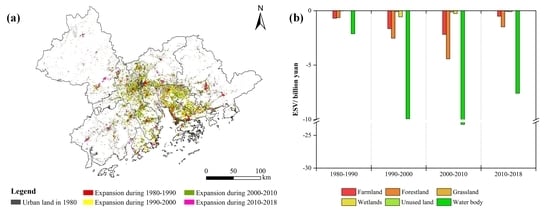Impacts of Urbanization on the Ecosystem Services in the Guangdong-Hong Kong-Macao Greater Bay Area, China
Abstract
1. Introduction
2. Materials and Methods
2.1. Study Area
2.2. Data Sources
2.3. Urban Expansion Analysis
2.4. Assessment of the Ecosystem Service Value
3. Results
3.1. Urban Expansion in the GBA
3.2. Ecosystem Service Value Changes
3.2.1. Changes in the Total ESV in the GBA
3.2.2. Changes in the ESV at the Regional Scale
3.2.3. Changes in the ESV in Response to the Different Growth Modes
4. Discussion
4.1. Spatial and Temporal Expansion of the Urban Areas
4.2. Ecosystem Service Changes Caused by Urbanization
4.3. Suggestions for Urban Planning
5. Conclusions
Supplementary Materials
Author Contributions
Funding
Acknowledgments
Conflicts of Interest
References
- Yang, C.; Li, Q.; Hu, Z.; Chen, J.; Shi, T.; Ding, K.; Guofeng, W. Spatiotemporal evolution of urban agglomerations in four major bay areas of US, China and Japan from 1987 to 2017: Evidence from remote sensing images. Sci. Total. Environ. 2019, 671, 232–247. [Google Scholar] [CrossRef] [PubMed]
- World Bank. World Development Indicators. Available online: http://data.worldbank.org/data-catalog/world-development-indicators/wdi-2011 (accessed on 13 September 2012).
- Bloom, D.E. 7 Billion and Counting. Science 2011, 333, 562–569. [Google Scholar] [CrossRef] [PubMed]
- Angel, S.; Parent, J.; Civco, D.L.; Blei, A.; Potere, D. The dimensions of global urban expansion: Estimates and projections for all countries, 2000-2050. Prog. Plan. 2011, 75, 53–107. [Google Scholar] [CrossRef]
- Grimm, N.B.; Faeth, S.H.; Golubiewski, N.E.; Redman, C.L.; Wu, J.; Bai, X.; Briggs, J.M. Global Change and the Ecology of Cities. Science 2008, 319, 756–760. [Google Scholar] [CrossRef]
- Cumming, G.S.; Buerkert, A.; Hoffmann, E.M.; Schlecht, E.; Von Cramon-Taubadel, S.; Tscharntke, T. Implications of agricultural transitions and urbanization for ecosystem services. Nat. Cell Biol. 2014, 515, 50–57. [Google Scholar] [CrossRef]
- Alphan, H. Land-use change and urbanization of Adana, Turkey. Land Degrad. Dev. 2003, 14, 575–586. [Google Scholar] [CrossRef]
- Çakir, G.; Ün, C.; Baskent, E.Z.; Kose, S.; Sivrikaya, F.; KeleşS. Evaluating urbanization, fragmentation and land use/land cover change pattern in Istanbul city, Turkey from 1971 TO 2002. Land Degrad. Dev. 2008, 19, 663–675. [Google Scholar] [CrossRef]
- Liu, X.; Li, X.; Chen, Y.; Tan, Z.; Li, S.; Ai, B. A new landscape index for quantifying urban expansion using multi-temporal remotely sensed data. Landsc. Ecol. 2010, 25, 671–682. [Google Scholar] [CrossRef]
- Li, C.; Li, J.; Wu, J. Quantifying the speed, growth modes, and landscape pattern changes of urbanization: A hierarchical patch dynamics approach. Landsc. Ecol. 2013, 28, 1875–1888. [Google Scholar] [CrossRef]
- Yang, X.J. China’s Rapid Urbanization. Science 2013, 342, 310. [Google Scholar] [CrossRef]
- Zhao, S.; Zhou, D.; Zhu, C.; Qu, W.; Zhao, J.; Sun, Y.; Huang, D.; Wu, W.; Liu, S. Rates and patterns of urban expansion in China’s 32 major cities over the past three decades. Landsc. Ecol. 2015, 30, 1541–1559. [Google Scholar] [CrossRef]
- Bosch, M.; Jaligot, R.; Chenal, J. Spatiotemporal patterns of urbanization in three Swiss urban agglomerations: Insights from landscape metrics, growth modes and fractal analysis. Landsc. Ecol. 2020, 35, 879–891. [Google Scholar] [CrossRef]
- Sun, Y.; Zhao, S. Spatiotemporal dynamics of urban expansion in 13 cities across the Jing-Jin-Ji Urban Agglomeration from 1978 to 2015. Ecol. Indic. 2018, 87, 302–313. [Google Scholar] [CrossRef]
- Dietzel, C.; Herold, M.; Hemphill, J.J.; Clarke, K.C. Spatio-temporal dynamics in California’s Central Valley: Empirical links to urban theory. Int. J. Geogr. Inf. Sci. 2005, 19, 175–195. [Google Scholar] [CrossRef]
- Wu, W.; Zhao, S.; Zhu, C.; Jiang, J. A comparative study of urban expansion in Beijing, Tianjin and Shijiazhuang over the past three decades. Landsc. Urban Plan. 2015, 134, 93–106. [Google Scholar] [CrossRef]
- White, R.; Engelen, G.; Uljee, I. Modeling Cities and Regions As Complex Systems; MIT Press: Cambridge, MA, USA, 2015. [Google Scholar]
- Costanza, R.; d’Arge, R.; de Groot, R.; Farber, S.; Grasso, M.; Hannon, B.; Limburg, K.; Naeem, S.; O’Neill, R.V.; Paruelo, J.; et al. The value of the world’s ecosystem services and natural capital. Nature 1997, 387, 253–260. [Google Scholar] [CrossRef]
- Millennium Ecosystem Assessment. Ecosystems and Human Well-Being: Synthesis; Island Press: Washington, DC, USA, 2005. [Google Scholar]
- Bateman, I.J.; Harwood, A.R.; Mace, G.M.; Watson, R.T.; Abson, D.J.; Andrews, B.; Binner, A.; Crowe, A.; Day, B.H.; Dugdale, S.; et al. Bringing Ecosystem Services into Economic Decision-Making: Land Use in the United Kingdom. Science 2013, 341, 45–50. [Google Scholar] [CrossRef]
- Braat, L.C.; De Groot, R. The ecosystem services agenda:bridging the worlds of natural science and economics, conservation and development, and public and private policy. Ecosyst. Serv. 2012, 1, 4–15. [Google Scholar] [CrossRef]
- Costanza, R.; De Groot, R.; Sutton, P.; Van Der Ploeg, S.; Anderson, S.J.; Kubiszewski, I.; Farber, S.; Turner, R.K. Changes in the global value of ecosystem services. Glob. Environ. Chang. 2014, 26, 152–158. [Google Scholar] [CrossRef]
- Xie, G.; Zhang, C.; Zhang, L.; Chen, W.; Li, S. Improvement of the Evaluation Method for Ecosystem Service Value Based on Per Unit Area. J. Nat. Resour. 2015, 30, 1243–1254. [Google Scholar]
- Xie, G.; Zhen, L.; Lu, C.; Xiao, Y.; Chen, C. Expert Knowledge Based Valua tion Method of Ecosystem Services in China. J. Nat. Resour. 2008, 23, 911–919. [Google Scholar]
- Estoque, R.C.; Murayama, Y. Landscape pattern and ecosystem service value changes: Implications for environmental sustainability planning for the rapidly urbanizing summer capital of the Philippines. Landsc. Urban Plan. 2013, 116, 60–72. [Google Scholar] [CrossRef]
- Xie, G.; Li, W.; Xiao, Y.; Zhang, B.; Lu, C.; An, K.; Wang, J.; Xu, K.; Wang, J. Forest ecosystem services and their values in Beijing. Chin. Geogr. Sci. 2010, 20, 51–58. [Google Scholar] [CrossRef]
- Li, F.; Zhang, S.; Yang, J.; Bu, K.; Wang, Q.; Tang, J.; Chang, L. The effects of population density changes on ecosystem services value: A case study in Western Jilin, China. Ecol. Indic. 2016, 61, 328–337. [Google Scholar] [CrossRef]
- Xu, L.; Xu, X.; Luo, T.; Zhu, G.; Ma, Z. Services based on land use: A case study of Bohai Rim. Geogr. Res. 2012, 31, 1775–1784. [Google Scholar]
- Statistics Bureau of the people’s Republic of China. China Statistical Yearbook; China Statistics Press: Beijing, China, 2012.
- Lin, M.; Lin, T.; Sun, C.; Jones, L.; Sui, J.; Zhao, Y.; Liu, J.; Xing, L.; Ye, H.; Zhang, G.; et al. Using the Eco-Erosion Index to assess regional ecological stress due to urbanization—A case study in the Yangtze River Delta urban agglomeration. Ecol. Indic. 2020, 111, 106028. [Google Scholar] [CrossRef]
- Yang, C.; Li, Q.; Zhao, T.; Liu, H.; Gao, W.; Shi, T.; Guan, M.; Guofeng, W. Detecting Spatiotemporal Features and Rationalities of Urban Expansions within the Guangdong-Hong Kong-Macau Greater Bay Area of China from 1987 to 2017 Using Time-Series Landsat Images and Socioeconomic Data. Remote. Sens. 2019, 11, 2215. [Google Scholar] [CrossRef]
- Lyu, R.; Zhang, J.; Xu, M.; Li, J. Impacts of urbanization on ecosystem services and their temporal relations: A case study in Northern Ningxia, China. Land Use Policy 2018, 77, 163–173. [Google Scholar] [CrossRef]
- Taubenböck, H.; Weigand, M.; Esch, T.; Staab, J.; Wurm, M.; Mast, J.; Dech, S. A new ranking of the world’s largest cities-Do administrative units obscure morphological realities? Remote Sens. Environ. 2019, 232, 111353. [Google Scholar] [CrossRef]
- Xu, X.; Liu, J.; Zhang, S.; Li, R.; Yan, C.; Wu, S. China’s Multi-Period Land Use Land Cover Remote Sensing Monitoring Data Set (CNLUCC); Resource and Environment Data Cloud Platform: Beijing, China, 2018. [Google Scholar]
- Dytham, C.; Forman, R.T.T. Land Mosaics: The Ecology of Landscapes and Regions. J. Ecol. 1996, 84, 787. [Google Scholar] [CrossRef]
- Xiao, H.; Li, H.; Wang, L.; Chen, J.; Han, Y. Changes of Land Use and Ecosystem Service Value in the Guangdong-Hong Kong-Macao Greater Bay Area-A Case Study of Guangdong-Foshan-Zhaoqing. Res. Soil. Water. Conserv. 2020, 27, 290–297. [Google Scholar]
- Xiao, R.; Lin, M.; Fei, X.; Li, Y.; Zhang, Z.; Meng, Q. Exploring the interactive coercing relationship between urbanization and ecosystem service value in the Shanghai-Hangzhou Bay Metropolitan Region. J. Clean. Prod. 2020, 253, 119803. [Google Scholar] [CrossRef]
- Zou, B. From Special Zone to Greater Bay Area-Shenzhen’s historical contribution and future responsibility to urbanization in China. Time. Archt. 2019, 04, 12–17. [Google Scholar]
- Hu, Y.; Liu, X.; Bai, J.; Shih, K.; Zeng, E.Y.; Cheng, H. Assessing heavy metal pollution in the surface soils of a region that had undergone three decades of intense industrialization and urbanization. Environ. Sci. Pollut. Res. 2013, 20, 6150–6159. [Google Scholar] [CrossRef] [PubMed]
- Chang, C.Y.; Yu, H.Y.; Chen, J.J.; Li, F.; Zhang, H.H.; Liu, C.P. Accumulation of heavy metals in leaf vegetables from agricultural soils and associated potential health risks in the Pearl River Delta, South China. Environ. Monit. Assess. 2013, 186, 1547–1560. [Google Scholar] [CrossRef] [PubMed]
- Mao, D.; Wang, Z.; Wu, J.; Wu, B.; Zeng, Y.; Song, K.; Yi, K.; Luo, L. China’s wetlands loss to urban expansion. Land. Degrad. Dev. 2018, 29, 2644–2657. [Google Scholar] [CrossRef]
- Chen, X.L.; Zhao, H.M.; Li, P.X.; Yin, Z.Y. Remote sensing image-based analysis of the relationship between urban heat island and land use/cover changes. Remote. Sens. Environ. 2006, 104, 133–146. [Google Scholar] [CrossRef]
- Wu, J.; Chow, K.; Fung, J.C.H.; Lau, A.K.H.; Yao, T. Urban heat island effects of the Pearl River Delta city clusters-their interactions and seasonal variation. Theor. Appl. Clim. 2010, 103, 489–499. [Google Scholar] [CrossRef]
- Xu, Q.; Yang, R.; Dong, Y.-X.; Liu, Y.-X.; Qiu, L.-R. The influence of rapid urbanization and land use changes on terrestrial carbon sources/sinks in Guangzhou, China. Ecol. Indic. 2016, 70, 304–316. [Google Scholar] [CrossRef]
- Ma, Z.; Melville, D.S.; Liu, J.; Chen, Y.; Yang, H.; Ren, W.; Zhang, Z.; Piersma, T.; Li, B. Rethinking China’s new great wall. Science 2014, 346, 912–914. [Google Scholar] [CrossRef]
- Chien, S.-S. Local farmland loss and preservation in China-A perspective of quota territorialization. Land Use Policy 2015, 49, 65–74. [Google Scholar] [CrossRef]
- Wang, J.; Lin, Y.; Glendinning, A.; Xu, Y. Land-use changes and land policies evolution in China’s urbanization processes. Land Use Policy 2018, 75, 375–387. [Google Scholar] [CrossRef]
- Tian, G.; Jiang, J.; Yang, Z.; Zhang, Y. The urban growth, size distribution and spatio-temporal dynamic pattern of the Yangtze River Delta megalopolitan region, China. Ecol. Model. 2011, 222, 865–878. [Google Scholar] [CrossRef]
- Peng, J.; Tian, L.; Liu, Y.; Zhao, M.; Hu, Y.; Wu, J. Ecosystem services response to urbanization in metropolitan areas: Thresholds identification. Sci. Total. Environ. 2017, 706–714. [Google Scholar] [CrossRef]
- Li, B.; Chen, D.; Wu, S.; Zhou, S.; Wang, T.; Chen, H. Spatio-temporal assessment of urbanization impacts on ecosystem services: Case study of Nanjing City, China. Ecol. Indic. 2016, 71, 416–427. [Google Scholar] [CrossRef]
- Narducci, J.; Quintas-Soriano, C.; Castro, A.J.; Som-Castellano, R.; Brandt, J. Implications of urban growth and farmland loss for ecosystem services in the western United States. Land Use Policy 2019, 86, 1–11. [Google Scholar] [CrossRef]
- Doherty, E.; Murphy, G.; Hynes, S.; Buckley, C. Valuing ecosystem services across water bodies: Results from a discrete choice experiment. Ecosyst. Serv. 2014, 7, 89–97. [Google Scholar] [CrossRef]
- Bai, X.; McPhearson, T.; Cleugh, H.; Nagendra, H.; Tong, X.; Zhu, T.; Zhu, Y.-G. Linking Urbanization and the Environment: Conceptual and Empirical Advances. Annu. Rev. Environ. Resour. 2017, 42, 215–240. [Google Scholar] [CrossRef]
- Wang, W.; Wu, T.; Li, Y.; Xie, S.; Han, B.; Zheng, H.; Ouyang, Z. Urbanization Impacts on Natural Habitat and Ecosystem Services in the Guangdong-Hong Kong-Macao “Megacity”. Sustainability 2020, 12, 6675. [Google Scholar] [CrossRef]
- Paterson, S.; Bryan, B.A. Food-Carbon Trade-offs between Agriculture and Reforestation Land Uses under Alternate Market-based Policies. Ecol. Soc. 2012, 17, 17. [Google Scholar] [CrossRef]
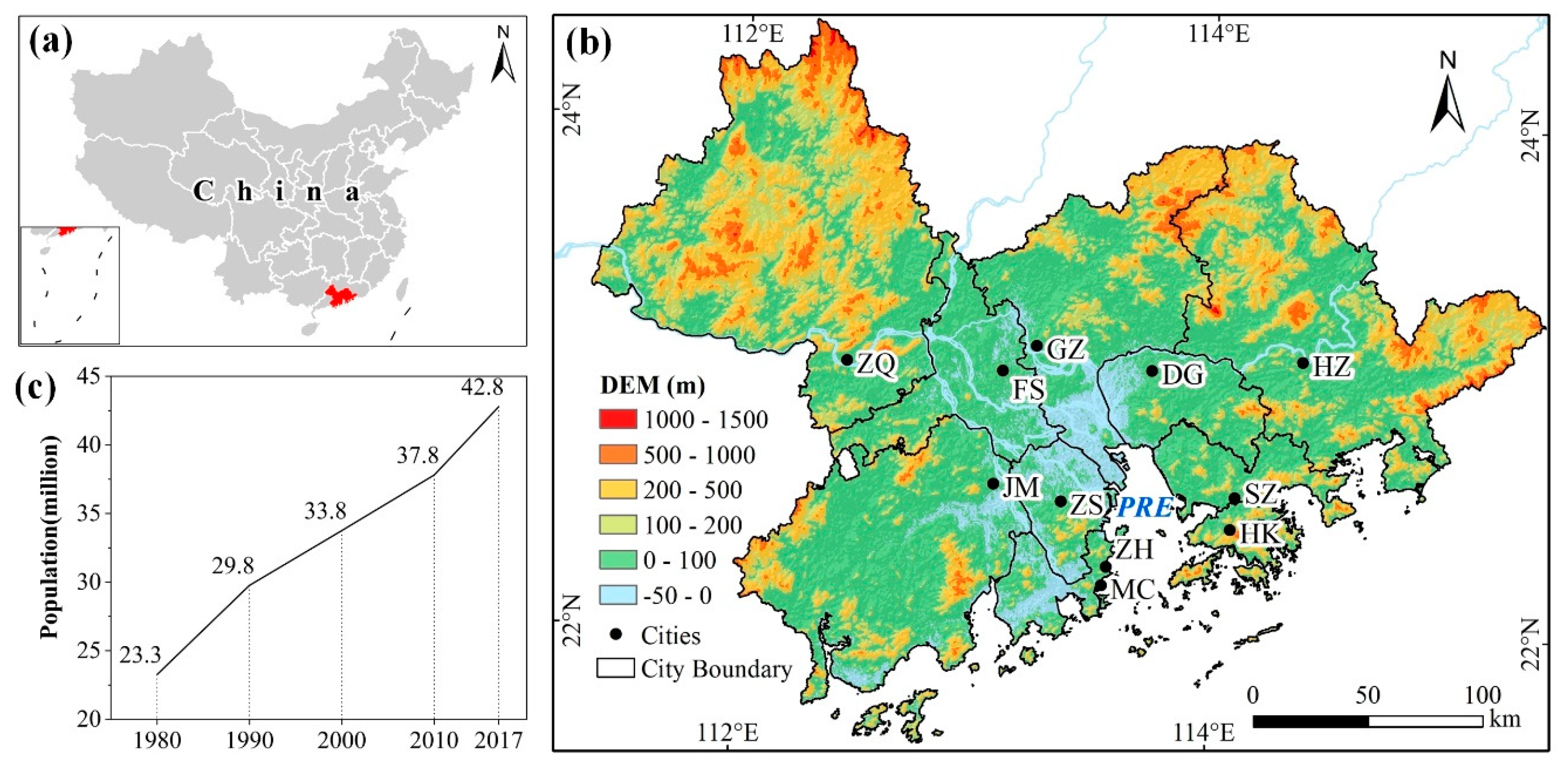
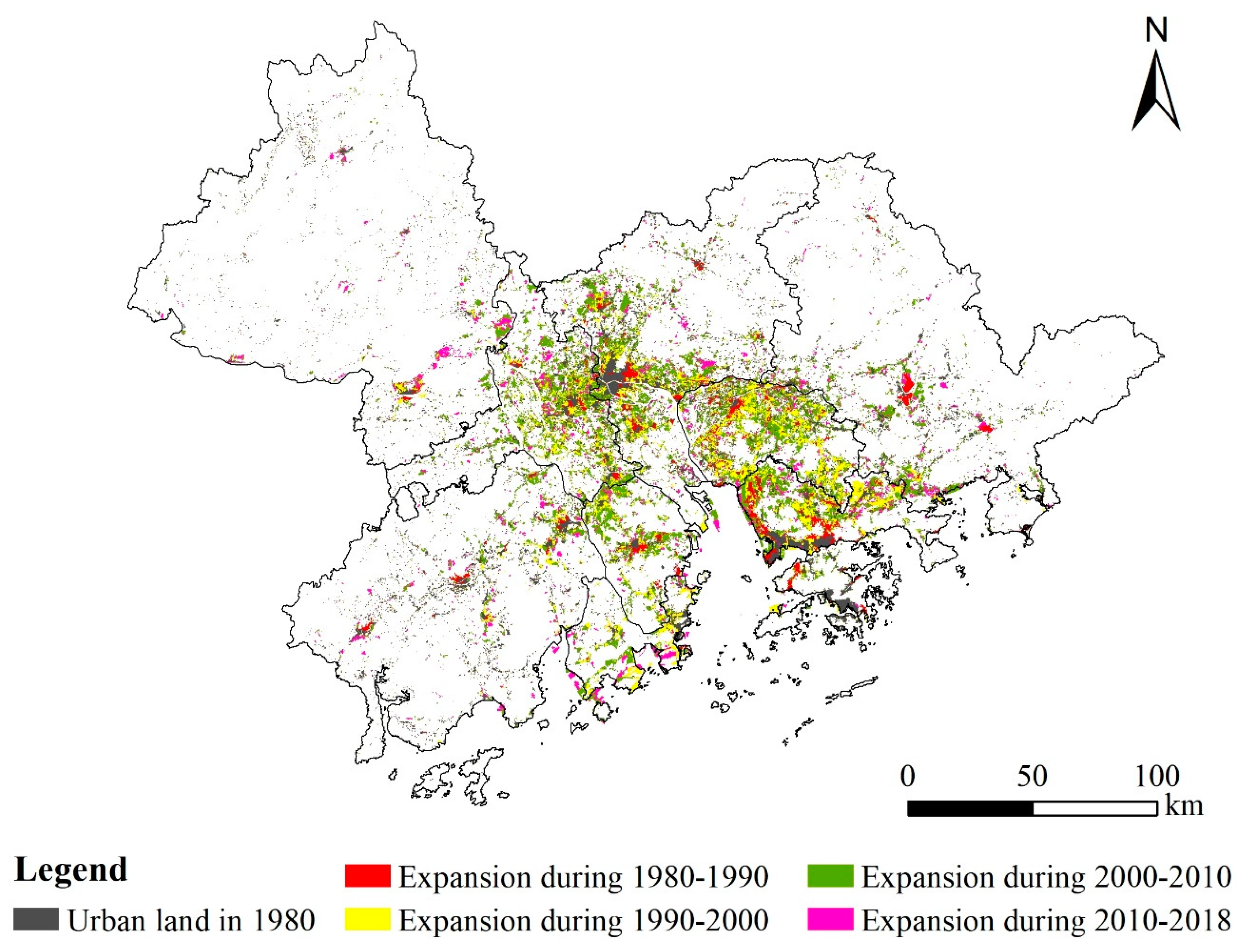
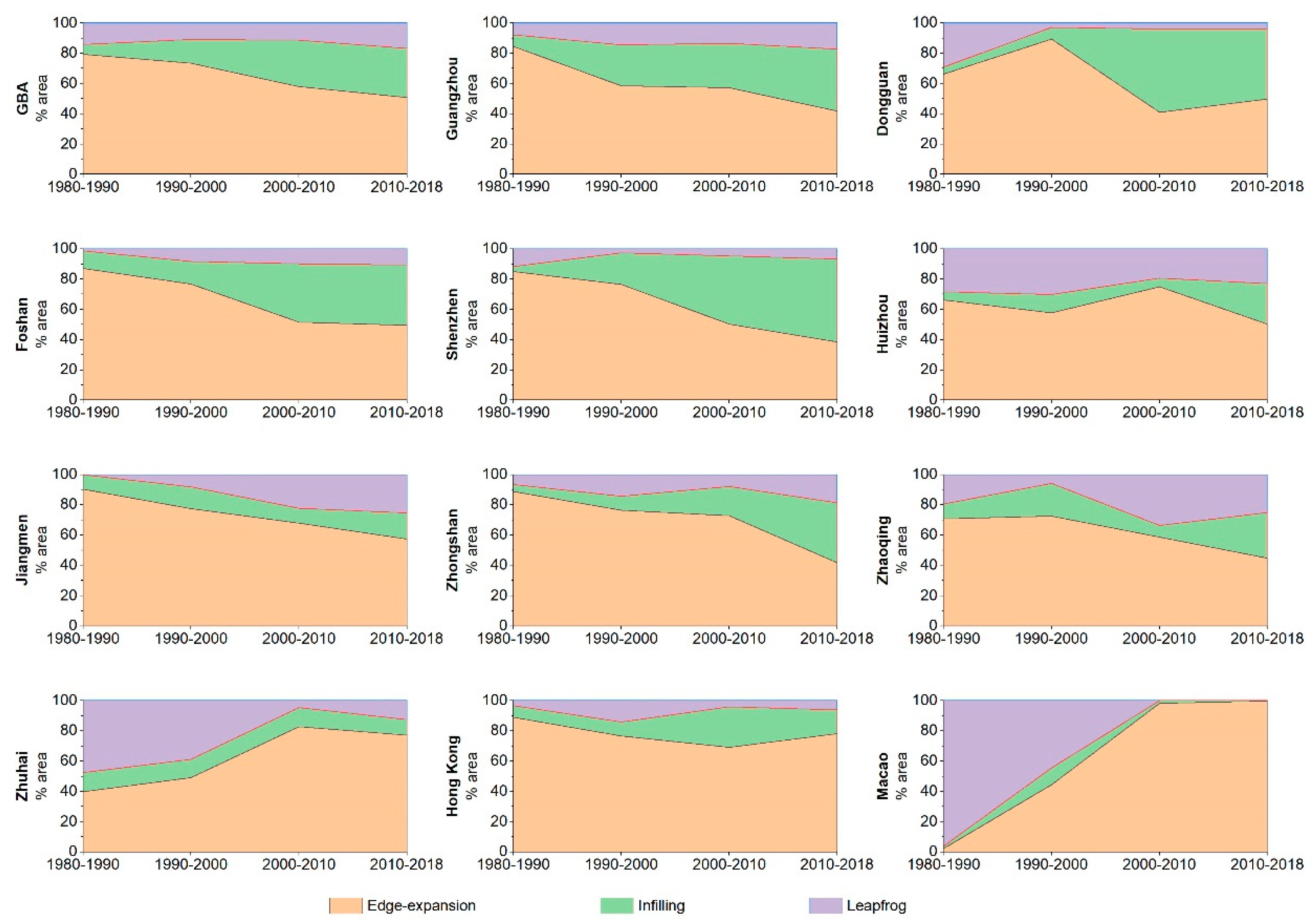
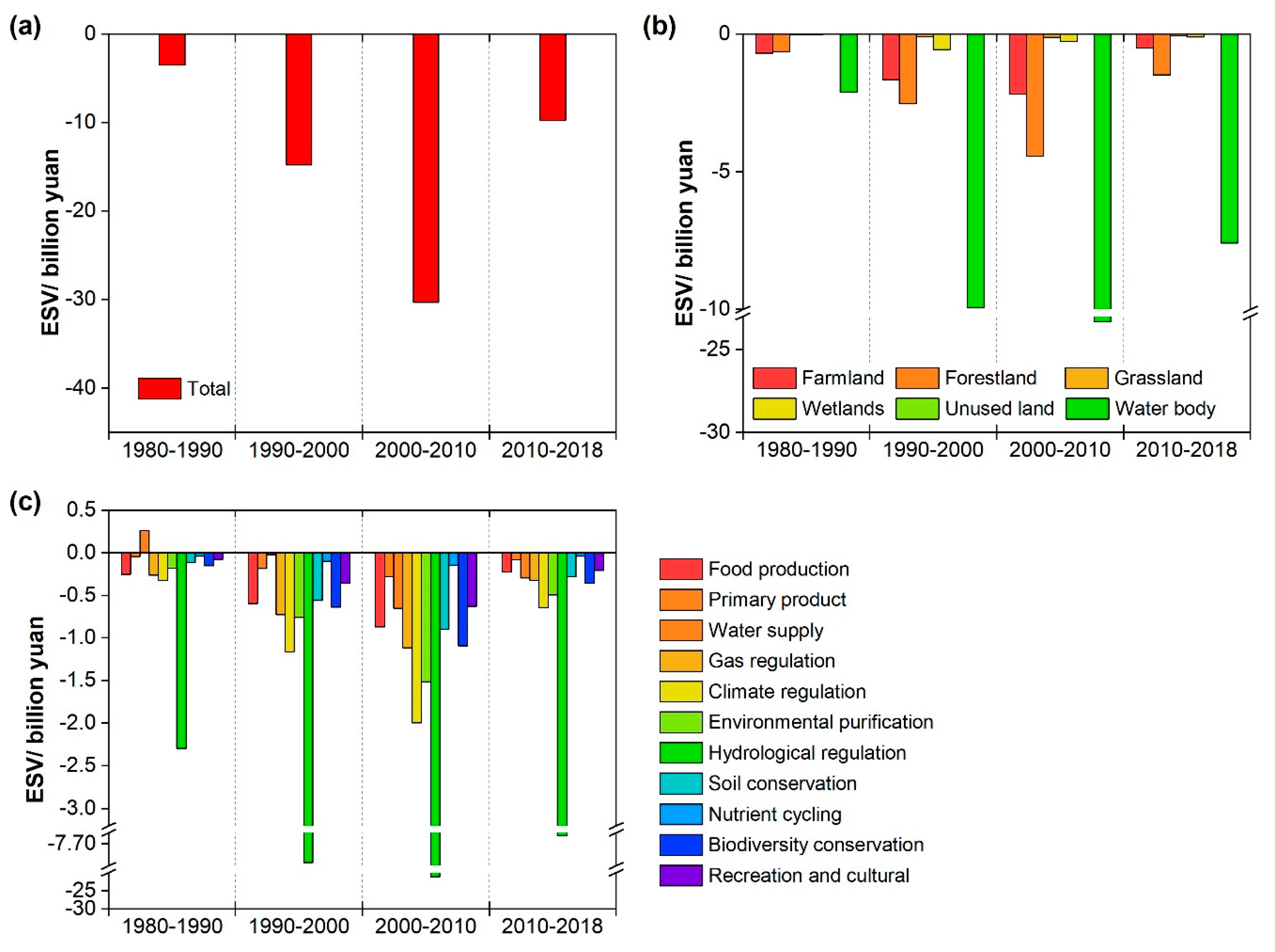
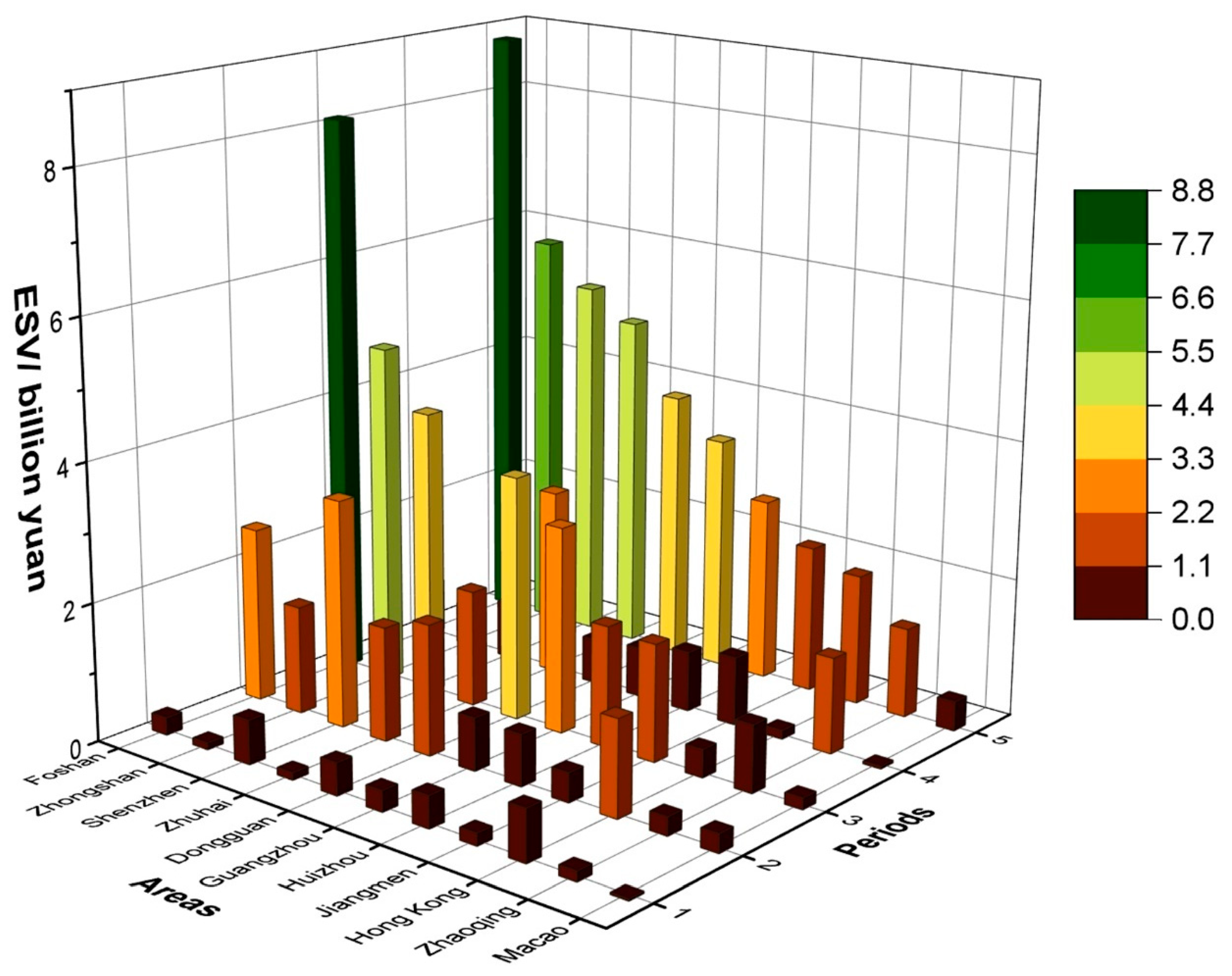
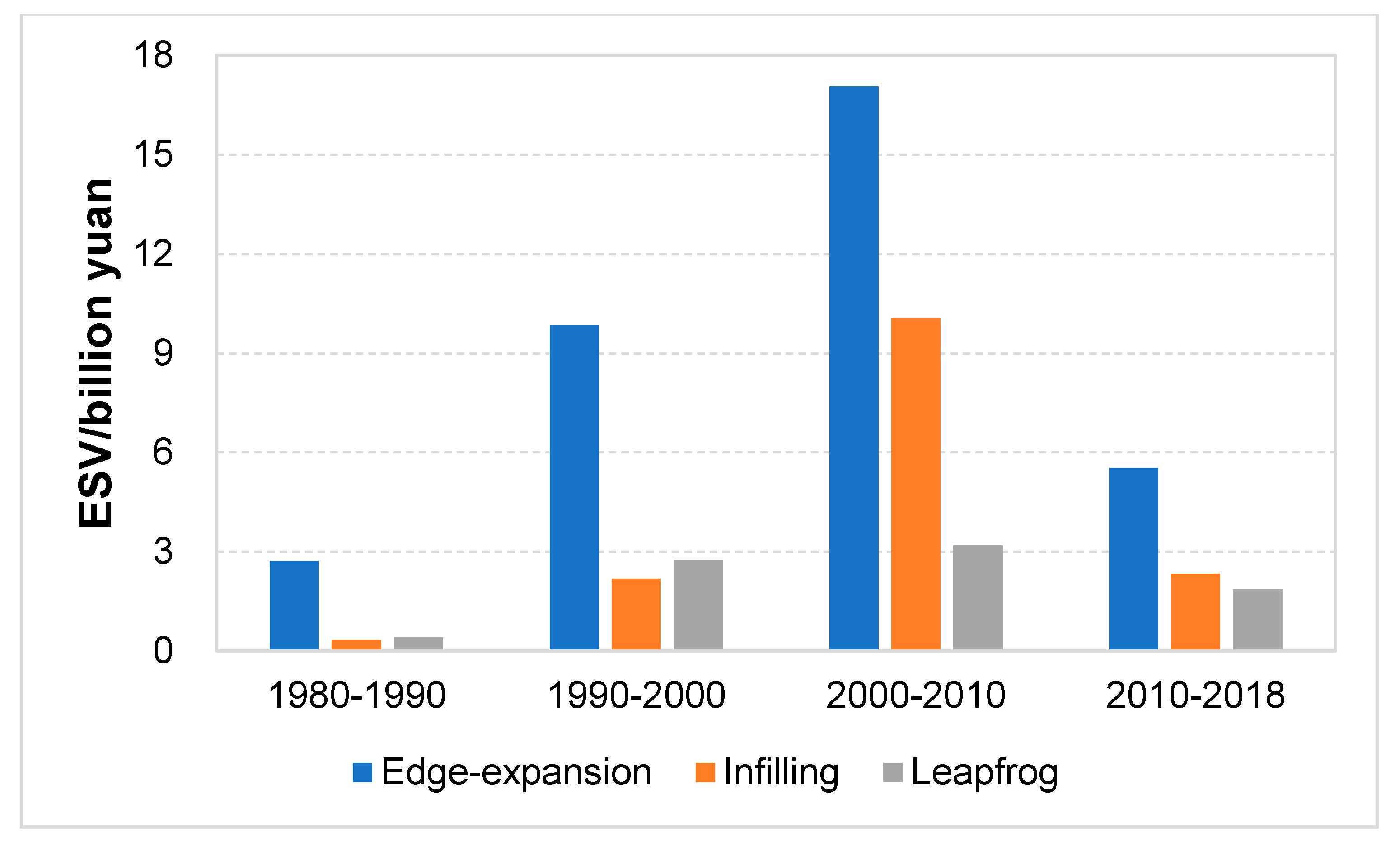
| Ecosystems | CNLUCC | ||
|---|---|---|---|
| Primary Classes | Subclasses | Subclasses | Codes |
| Farmland | Dry farmland | Dry farmland | 12 |
| Paddy field | Paddy field | 11 | |
| Forestland | Broad-leaved forest | Forest | 21 |
| Shrubs | Shrubs | 22 | |
| Shrubs | Sparse woods | 23 | |
| Shrubs | Other forestland | 24 | |
| Grassland | Grassland | High-coverage grassland | 31 |
| Brush grass | Medium-coverage grassland | 32 | |
| Meadow | Low-coverage grassland | 33 | |
| Wetlands | Wetland | Tidal flat | 45 |
| Wetland | Beach | 46 | |
| Wetland | Marshland | 64 | |
| Unused land | Desert | Sand | 61 |
| Bare land | Bare land | 65 | |
| Bare land | Bare rock | 66 | |
| Water body | River system | Rivers and canals | 41 |
| River system | Lake | 42 | |
| River system | Reservoir pond | 43 | |
| River system | Sea | 99 | |
| Urban areas | Urban residential area | 51 | |
| Rural residential area | 52 | ||
| Other construction land | 53 |
| Areas | Area (km2) | AI (km2/year) | AEI (%) | ||||||||||||
|---|---|---|---|---|---|---|---|---|---|---|---|---|---|---|---|
| 1980 | 1990 | 2000 | 2010 | 2018 | T1 | T2 | T3 | T4 | T5 | T1 | T2 | T3 | T4 | T5 | |
| GBA | 2607.4 | 3085.7 | 4576.5 | 7373.7 | 8243.5 | 47.8 | 149.1 | 279.7 | 108.7 | 148.3 | 1.7 | 4.0 | 4.9 | 1.4 | 3.1 |
| Guangzhou | 532.7 | 618.9 | 841.4 | 1358.0 | 1471.9 | 8.6 | 22.3 | 51.7 | 14.2 | 24.7 | 1.5 | 3.1 | 4.9 | 1.0 | 2.7 |
| Jiangmen | 425.7 | 462.7 | 526.5 | 684.4 | 800.8 | 3.7 | 6.4 | 15.8 | 14.6 | 9.9 | 0.8 | 1.3 | 2.7 | 2.0 | 1.7 |
| Huizhou | 333.0 | 380.0 | 411.1 | 704.8 | 842.7 | 4.7 | 3.1 | 29.4 | 17.2 | 13.4 | 1.3 | 0.8 | 5.5 | 2.3 | 2.5 |
| Foshan | 313.7 | 345.5 | 555.4 | 1076.4 | 1183.6 | 3.2 | 21.0 | 52.1 | 13.4 | 22.9 | 1.0 | 4.9 | 6.8 | 1.2 | 3.6 |
| Dongguan | 242.3 | 318.5 | 694.3 | 1179.9 | 1244.4 | 7.6 | 37.6 | 48.6 | 8.1 | 26.4 | 2.8 | 8.1 | 5.4 | 0.7 | 4.4 |
| Zhaoqing | 240.0 | 247.5 | 285.3 | 389.6 | 507.1 | 0.7 | 3.8 | 10.4 | 14.7 | 7.0 | 0.3 | 1.4 | 3.2 | 3.3 | 2.0 |
| Shenzhen | 204.3 | 330.3 | 596.0 | 909.1 | 992.1 | 12.6 | 26.6 | 31.3 | 10.4 | 20.7 | 4.9 | 6.1 | 4.3 | 1.1 | 4.2 |
| Hong Kong | 145.3 | 175.6 | 211.2 | 235.7 | 239.2 | 3.0 | 3.6 | 2.5 | 0.4 | 2.5 | 1.9 | 1.9 | 1.1 | 0.2 | 1.3 |
| Zhongshan | 87.8 | 117.8 | 214.2 | 491.6 | 525.0 | 3.0 | 9.6 | 27.7 | 4.2 | 11.5 | 3.0 | 6.2 | 8.7 | 0.8 | 4.8 |
| Zhuhai | 77.0 | 80.3 | 224.9 | 325.9 | 417.3 | 0.3 | 14.5 | 10.1 | 11.4 | 9.0 | 0.4 | 10.8 | 3.8 | 3.1 | 4.5 |
| Macao | 5.7 | 8.7 | 16.2 | 18.4 | 19.5 | 0.3 | 0.7 | 0.2 | 0.1 | 0.4 | 4.4 | 6.4 | 1.3 | 0.7 | 3.3 |
© 2020 by the authors. Licensee MDPI, Basel, Switzerland. This article is an open access article distributed under the terms and conditions of the Creative Commons Attribution (CC BY) license (http://creativecommons.org/licenses/by/4.0/).
Share and Cite
Wang, X.; Yan, F.; Su, F. Impacts of Urbanization on the Ecosystem Services in the Guangdong-Hong Kong-Macao Greater Bay Area, China. Remote Sens. 2020, 12, 3269. https://doi.org/10.3390/rs12193269
Wang X, Yan F, Su F. Impacts of Urbanization on the Ecosystem Services in the Guangdong-Hong Kong-Macao Greater Bay Area, China. Remote Sensing. 2020; 12(19):3269. https://doi.org/10.3390/rs12193269
Chicago/Turabian StyleWang, Xuege, Fengqin Yan, and Fenzhen Su. 2020. "Impacts of Urbanization on the Ecosystem Services in the Guangdong-Hong Kong-Macao Greater Bay Area, China" Remote Sensing 12, no. 19: 3269. https://doi.org/10.3390/rs12193269
APA StyleWang, X., Yan, F., & Su, F. (2020). Impacts of Urbanization on the Ecosystem Services in the Guangdong-Hong Kong-Macao Greater Bay Area, China. Remote Sensing, 12(19), 3269. https://doi.org/10.3390/rs12193269





